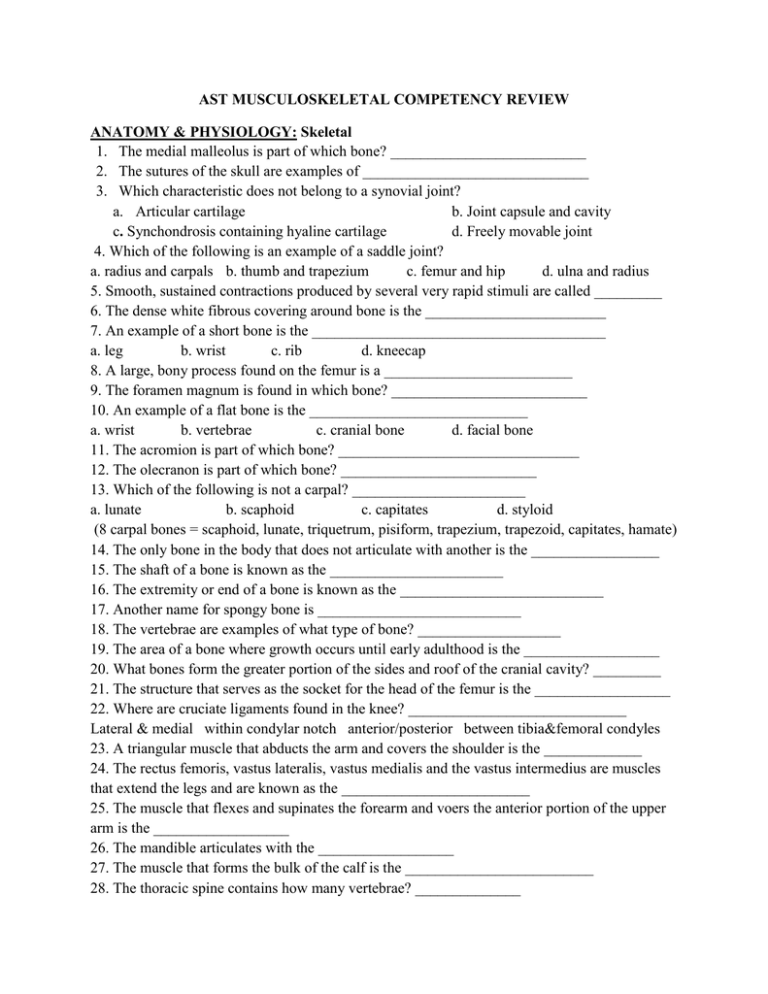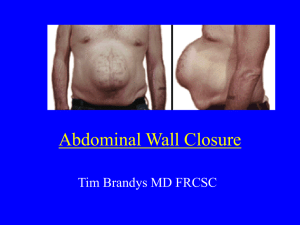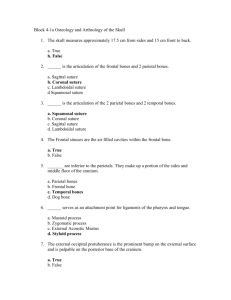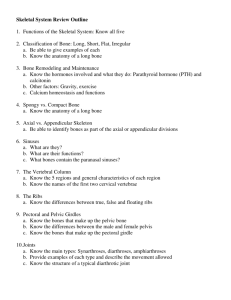AST MUSCULOSKELETAL COMPETENCY REVIEW ANATOMY
advertisement

AST MUSCULOSKELETAL COMPETENCY REVIEW ANATOMY & PHYSIOLOGY: Skeletal 1. The medial malleolus is part of which bone? __________________________ 2. The sutures of the skull are examples of ______________________________ 3. Which characteristic does not belong to a synovial joint? a. Articular cartilage b. Joint capsule and cavity c. Synchondrosis containing hyaline cartilage d. Freely movable joint 4. Which of the following is an example of a saddle joint? a. radius and carpals b. thumb and trapezium c. femur and hip d. ulna and radius 5. Smooth, sustained contractions produced by several very rapid stimuli are called _________ 6. The dense white fibrous covering around bone is the ________________________ 7. An example of a short bone is the _______________________________________ a. leg b. wrist c. rib d. kneecap 8. A large, bony process found on the femur is a _________________________ 9. The foramen magnum is found in which bone? __________________________ 10. An example of a flat bone is the _____________________________ a. wrist b. vertebrae c. cranial bone d. facial bone 11. The acromion is part of which bone? ________________________________ 12. The olecranon is part of which bone? __________________________ 13. Which of the following is not a carpal? _______________________ a. lunate b. scaphoid c. capitates d. styloid (8 carpal bones = scaphoid, lunate, triquetrum, pisiform, trapezium, trapezoid, capitates, hamate) 14. The only bone in the body that does not articulate with another is the _________________ 15. The shaft of a bone is known as the _______________________ 16. The extremity or end of a bone is known as the ___________________________ 17. Another name for spongy bone is ___________________________ 18. The vertebrae are examples of what type of bone? ___________________ 19. The area of a bone where growth occurs until early adulthood is the __________________ 20. What bones form the greater portion of the sides and roof of the cranial cavity? _________ 21. The structure that serves as the socket for the head of the femur is the __________________ 22. Where are cruciate ligaments found in the knee? _____________________________ Lateral & medial within condylar notch anterior/posterior between tibia&femoral condyles 23. A triangular muscle that abducts the arm and covers the shoulder is the _____________ 24. The rectus femoris, vastus lateralis, vastus medialis and the vastus intermedius are muscles that extend the legs and are known as the _________________________ 25. The muscle that flexes and supinates the forearm and voers the anterior portion of the upper arm is the __________________ 26. The mandible articulates with the __________________ 27. The muscle that forms the bulk of the calf is the _________________________ 28. The thoracic spine contains how many vertebrae? ______________ 29. An abnormal thoracic curve of the spine resulting in the pathology referred to as “hunchback” is called _________________________ 30. The complete displacement of a joint is referred to as a/an ____________________ 31. A cyst in the popliteal fossa is called a/an _____________________ 32. The medical term for a bunion is __________________________ 35. What term describes a fracture in which the bone penetrates the skin? _______________ ANATOMY & PHYSIOLOGY: Muscles 1. A triangular muscle that abducts the arm and covers the shoulder is the _____________ a. Latissimus b. deltoid c. trapezius d. rhomboideus 2. The rectus femoris, vastus lateralis, vastus medialis and the vastus intermedius are muscles that extend the legs are are known as the _____________________________ a. Quadriceps b. peroneus longus c. hamstrings d. adductor longus 3. The muscle that flexes and supinates the forearm and covers the anterior portion of the upper arm is the ___________________________ a. Teres major b. biceps brachii c. flexor radialis d. deltoid 4. The muscle that forms the bulk of the upper calf if the ________________________ a. Quadriceps b. hamstrings c. gastrocnemius d. biceps femoris 5. Where are the cruciate ligaments found in the knee? a. Lateral and medial b. within the condylar notch c. anterior and posterior d. between tibial and femoral condyles SUTURES AND WOUND CLOSURE DEVICES: 1. Most absorbable sutures are packaged in an alcohol water solution to maintain their ____ a. Sterility b. Length c. Pliability d. Strength 2. A curved, tapered surgical needle is used most often on ____ a. Skin b. Eye tissue c. Tendon d. Bowel tissue 3. The least inert of all the synthetic meshes is _____ a. Polyglactin 910 b. Stainless steel c. Polyester fiber d. Polypropylene 4. A mesh that is not preferred in the presence of infection is____________ a. Prolene b. Mersilene c. Vicryl d. Stainless steel 5. Which of the following sutures generally would not be used in the presence of infection? __ a. Silk b. chromic c. steel d. polypropylene 6. The measure of weight required to break a suture is its ___ a. Yield power b. Tensile strength c. Gauge d. Taut 7. Which type of needle point would be selected for use on tendon? ___ a. Taper b. Cutting c. Blunt d. Side cutting 8. The type of needle point used on peritoneum and intestine is ____ a. Taper b. Blunt c. Trocar d. Side cutting 9. A type of suture that has a high tensile strength and supports a wound indefinitely is _____ a. Silk b. Stainless steel c. Polyester fiber d. Dacron 10. A stick tie is a/an ____ a. Free tie b. Continuous suture c. Swaged needle d. Free needle 11. A characteristic of polyglycolic acid sutures is that they are _____ a. Absorbable b. Encapsulated c. Nonabsorbable d. Retain memory 12. Tissue trauma is best minimized using a ____ a. Threaded suture b. braided suture c. swaged on suture d. free tie 13. Which suture is treated with a salt solution to decrease the rate of absorption? ____ a. Plain gut b. Vicryl c. Chromic d. Nylon 14. Utilizing electric current to close severed vessels is called ____ a. Coagulation b. Hemostasis c. Fulguration d. Dissection 15. Absorbable suture is generally preferred in suturing which of the following tissue? _____ a. Muscle b. Periosteum c. Tendon d. Ligament 16. A suture used in tendon repair is ___ a. Nylon b. Polyglycolic acid c. Silk d. Polydioxanone 17. Which of the following sutures is a polyester fiber suture? a. Vicryl b. Dexon c. Ethibond Excel d. Novafil 18. The most widely used nonabsorbable suture is ___ a. Nylon b. Polyester c. Chromic d. Polypropylene 19. Which of the following suture sizes is the smallest in diameter? ____ a. 4-0 b. 2-0 c. 0 d. 2 20. Which of the following sutures is absorbable and offers extended wound support? a. Vicryl b. Polydioxanone c. Silk d. Poliglecaprone 21. Bolsters are used with retention sutures to ____ a. Prevent suture from cutting skin c. Prevent unequal tensions b. Facilitate easy removal d. retract vessels 22. What type of suture is Surgilon? __ a. Absorbable b. Nylon c. Monofilament d. Noncoated 23. Another name for polyglactin 910 is _____ a. Ethibond Excel b. Dexon c. Vicryl d. PDS 24. Which tissue type would contradict the use of a cutting needle? ___ a. Eye b. Nerve c. Tendon d. Skin 25. Ligatures are used to ______ a. Occlude lumens of blood vessels c. Retract vessels b. Bring tissue together d. Approximate skin edges 26. Which of the following is the least reactive of all synthetic suture materials? ___ a. Silk b. Polypropylene c. Nylon d. Polyester 27. A protein substance that is the chief constituent of connective tissue is __ a. Collagen b. Fibrin c. Elastin d. Epithelium 28. Which type of needle point would be selected for use on the skin? ____ a. Taper b. Cutting c. Blunt d. Side cutting 29. If tissue is approximated too tight, it can cause ____ a. Ischemia b. Keloids c. Adhesions d. Dehiscence 30. The space caused by separation of the wound edges is called ___ a. Evisceration b. Dead space c. Herniation d. Sinus tract 31. What type of needle would be used on the liver? ____ a. Side cutting b. Trocar c. Blunt d. Reverse cutting 32. A characteristic of plain gut is that is absorbs in ____________ days a. 70 b. 53 c. 36 d. 19 33. An excellent substitute that provides strength and nonreactivity in tissues where stainless cannot be used is ___ a. Nylon b. Polyethylene c. Polypropylene d. Polyester 34. What type of needle is used on tissue of the gastrointestinal tract? ___ a. Taper b. Reverse cutting c. Blunt d. Conventional cutting






